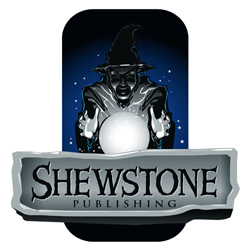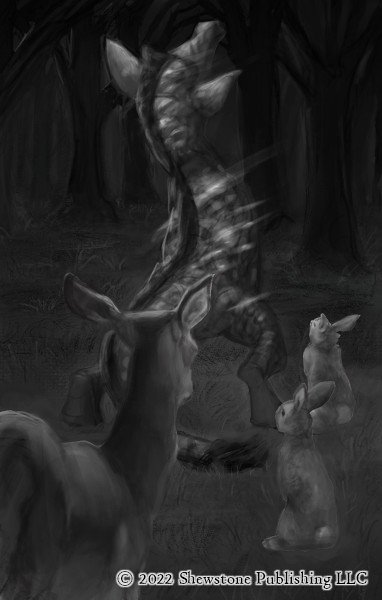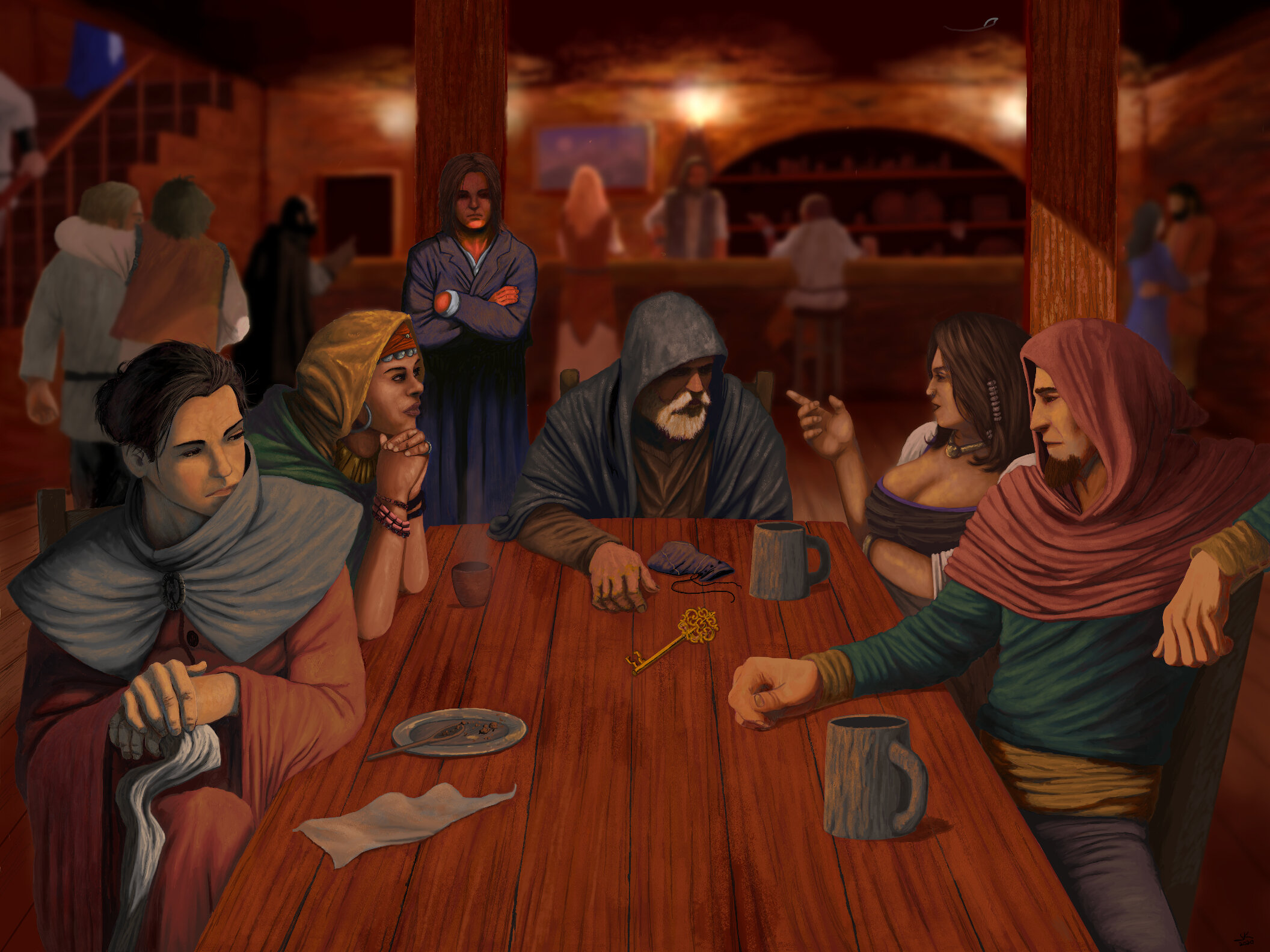On the surface, the basilisk is terrifying. It can kill you by looking at you. Contrary to how it’s portrayed in D&D, your character doesn’t have to look at it. The particular version of the basilisk we used kills you in an interesting way: by setting you on fire. Spontaneous human combustion! It’s so toxic, it can also kill you if you touch it. Indeed, according to classical bestiary author Pliny the Elder, even if you touch it with a long spear, its venom will run up the spear and kill you.
It also has the Aspect, Small Lizard Chicken. I was using the cockatrice variant—the Bestiary manuscript has a lot of variations of the basilisk. It’s the size of a chicken. The basilisk is a proverbial glass cannon. All you have to do is figure out how to attack it without touching it and without it looking at you.
My players are quite experienced with Magonomia. They probably have more experience playing Magonomia than anyone else in the United States. They’re also planners. I knew if I gave them time to plan, they’d spend a lot of time on it but they’d come up with something good.
So I didn’t give them time to plan. I just told them “you’re at your local pub in London. Outside, you hear screams and a panicked crowd runs past shouting ‘run for your lives! A cockatrice is on the loose!’” It’s a playtest, I’m not aiming for a deep plot here.
I did brief them that as wizards, their characters would know about the poison traveling up the spear to kill its wielder, and that the basilisk’s deadly gaze only requires one-way contact. That spooked the players a little.
Laying Ambush
A group of four Magonomia wizards are quite powerful when they work together. Spells in Magonomia are meant to be used creatively, and this group has lots of experience with that.
Ghida climbed onto a rooftop and lay low, peering over the roof’s peak to watch for the cockatrice’s approach. She was the one who saw it setting scenery and livestock on fire as rampaged down the street. She began applying her potion Balm of Protection from Fire to her face. Normally that potion takes a minute to thoroughly apply to the whole body, but it can be applied hastily to protect only one body part. Ghida’s player chose her face because it was most likely to be exposed to the basilisk’s attack.
Aonghas wanted to draw the cockatrice into a side alley, but he didn’t have a spell that could be useful. This isn’t unusual in Magonomia. Each wizard starts with a repertoire of 11 spells and each spell has a fairly specific purpose. Lacking a spell for the task at hand, he fell back on his wits, as any good Magonomia wizard will do. He grabbed a roast chicken from the window of an abandoned poultry shop and tossed it in the alley near its entrance.
Christopher grabbed a crate of apples that had been overturned in the street. He emptied it out and turned it upside down, then used Levitation to raise it into the air as a makeshift trap, to drop on the cockatrice when it went to the roast chicken.
Gemini tried to climb up onto the roof alongside Ghida, but failed the Athletics Overcome action and accepted failure. Gemini just isn’t that good at physical tasks. They stayed put, out of harm’s way but also out of position
Springing the Trap
Our versions of the example characters have been on several harrowing adventures in their playtest careers. They’ve passed a few Breakthroughs and therefore have added extra spells to their repertoires. Ghida had acquired Pyrotechnics, which produces amazing magical fireworks, much like Gandalf used in the Fellowship of the Rings movie. She readied that potion, thinking to temporarily blind the cockatrice when it got close.
Aonghas realized Christopher would need to see the cockatrice in order to spring his levitating crate trap. Aonghas also realized that if the cockatrice needed to see its victim, invisibility might help. He quickly applied the Fern-Seed Potion (a spell of invisibility) to Christopher, then ducked for cover around the corner.
Most of Gemini’s spells take a long time to cast. That’s one of the occupational hazards of being an astrologer. They fell back on a decidedly less erudite approach: they pried up a cobble-stone with their cane and hid around the corner, ready to hurl the stone at the cockatrice after Ghida blinded it with her fireworks.
The cockatrice didn’t cooperate. Aonghas failed his Deception roll to lure it down the alley. It wasn’t especially interested in eating the roast chicken. It glared at it and burst it into flames instead! Ghida changed her plan a bit and set off her fireworks behind the creature. It startled and rushed forward—under Christopher’s trap! Christopher needed to cancel his Levitation spell with split-second timing to drop the crate onto a moving target. His player suggested Academics could be an appropriate skill for that task. We narrated a quick and anachronistic vignette of Christopher imagining engineering diagrams in his mind’s eye. He made the first high-stakes combat geometry dice roll of our gaming careers. Success! The cockatrice was trapped.
Although there was plenty of suspense at the gaming table, when you read the account of the battle, the players made it look easy. Such is the power of wizards using their spells together as a team.
Combusting Aonghas
Since this was a playtest, we also wanted to explore what would happen if the cockatrice escaped the trap and had a chance to use its gaze attack.
Startled by Ghida’s fireworks, the cockatrice flapped frantically into the alley, too fast for Christopher to react. For a heart-stopping moment it was flying right toward Christoper at eye level. Christopher stood perfectly still and his invisibility saved him: the cockatrice looked right through him without any effect.
Aonghas wasn’t so lucky. The cockatrice had moved far enough down the alley to have line of sight around the corner where he was hiding. Its head swiveled toward him … he tried to duck out of sight in time … with a sinister cluck it rolled its Legendary (+8) gaze attack vs. Aonghas’s Average (+1) Stealth. Fwoosh! Aonghas burst into flames, losing all his physical stress boxes and taking a Moderate Consequence.
To the game master, these seem like disappointingly minor burns. Aonghas’s player considered his character lucky to be alive.
We closed the curtain at that point because I know how deadly player characters get when they’re fighting for their lives.
Modifications Due to This Playtest
This was actually the second playtest of the basilisk. In the first one, its gaze attack really under-performed, leading me to increase it to Legendary (+8). I briefly considered increasing it again because a Moderate Consequence seemed like a pretty mild outcome from getting blasted by one of the deadliest monsters in European folklore.
This is where playability needs to be considered. The important question is not how badly is Aonghas impaired after the first hit, it’s how likely is he to survive a second. I’d give him less than even odds. A player who knows Fate would see the wisdom of using the Concede rule to chicken out (pun intended).
No one is likely to complain about their character surviving their first hit from a basilisk’s gaze. They might complain if they think it was underwhelming. Feeling lucky to be alive is a lot more fun than being carried off on a stretcher—or in a dustpan. I conclude the numbers are about right.
The only change I ended up making was to edit the text to clarify that the basilisk needs to see its target to attack, not the other way round.
Although the basilisk is very dangerous, a group of wizards has the tools to deal with it. It’s designed to be scary and to require ingenuity to defeat. This version worked exactly as intended.






